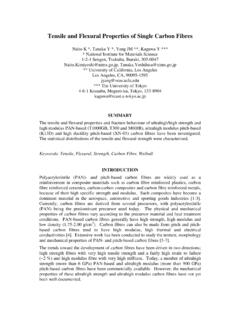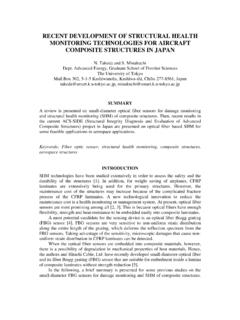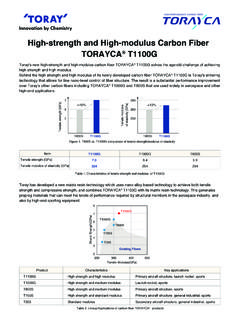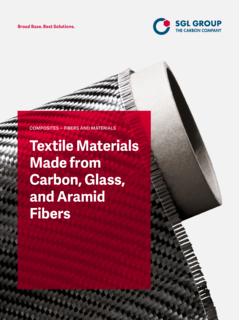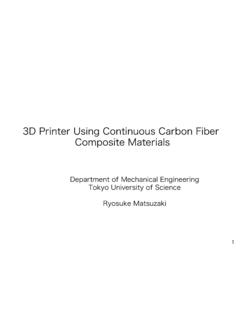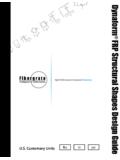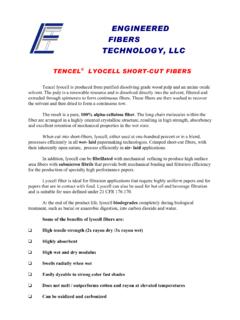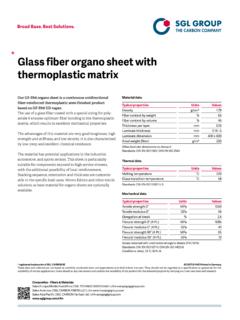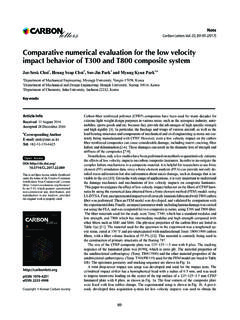Transcription of TENSILE STRENGTH OF CARBON-CARBON …
1 TENSILE STRENGTH OF CARBON-CARBON COMPOSITES AT high TEMPERATURE UP TO 2773K Hiroshi Kobayashi* Ken Goto** Hiroshi Hatta** Masashi Koyama** Hiroshi Fukuda** *Graduate school, Tokyo University of Science **Institute of Space and Astronautical Science, Japan Aerospace Explaration Agency **Material science and technology, Tokyo University of Science 3-1-1 Yoshinodai, Sagamihara, Kanagawa 229-8510, Japan Summary Author s previous works revealed that TENSILE STRENGTH of C/C especially enhances up at 2773K. In order to reveal the mechanisms of the remarkable enhancing TENSILE STRENGTH at 2773K, mechanical properties of the C/C subjected to different heat treatment temperatures and to pre-creep deformation were examined. A course of discussion lead to a conclusion that creep deformation of fiber is a main source of the STRENGTH enhancement.
2 Keywords: CARBON-CARBON composites, high temperature, TENSILE STRENGTH 1. Introduction CARBON-CARBON composites (C/Cs) are lightweight material that maintains high TENSILE STRENGTH and Young s modulus up to more than 2273K. For this advantage, C/Cs are used in various high temperature structures, , the components of heat resistant structures such as rocket nozzles and atomic furnaces.[1]-[4] However, the mechanical properties of C/Cs at elevated temperatures are not well understood. Only a few reports had been published concerning this issue.[3]-[6] However, the results had been contradictory even with regard to the temperature dependence of TENSILE STRENGTH or flexural STRENGTH . The present author s previous works revealed that TENSILE STRENGTH of C/Cs enhances up to 2773K.
3 In particular, it is noted that the TENSILE STRENGTH of C/Cs at 2773K have enhanced to reach twice as high as that at room temperature.[7] According to the previous discussion, the enhancement of TENSILE STRENGTH arose from de-gas effect (<1873K) and from creep deformation (>1873K). In general, enhancement of the TENSILE STRENGTH of C/Cs is attributed to three factors; the strengths of the fiber, matrix and their interface. However, it has not been clarified among these three terms which factor mainly affects the TENSILE STRENGTH . In our previous work, test temperature at 2773K exceeds heat treatment temperature (HTT) of the fabrication stage of C/C at 2273K, so that the mechanical properties of C/Cs were very likely changed by test temperature higher than the original HTT of C/Cs. In the present study, in order to reveal the mechanism ruling the enhancing TENSILE STRENGTH at high temperature, mechanical properties of C/C heat-treated at two temperatures (2273K and 2773K) and those after creep deformation were examined.
4 2. Experimental procedure Materials The C/C used in this study was supplied by Across Corp., Japan, and was fabricated using the preformed yarn method,[8] where the yarns of PAN-based carbon fiber (TORAYCA M40, TORAY, Japan) bundled into 6000 filaments was used for the reinforcement. The C/C was symmetrically laminated in a cross-ply stacking sequence [0/90]8s, and densified into a volume fraction the fibers of 50% after heat treatment at 2273K. For the evaluation of TENSILE STRENGTH at elevated temperatures up to 2773K, a part of the C/Cs was further heat-treated at 2773K, where temperature was controlled at a constant heating and cooling rates of 10K/min. Hereafter, the C/C thus heat-treated will be designated as HTT2773K. Effect of HTT on TENSILE STRENGTH of C/Cs In order to examine the effect of heat-treatment temperature (HTT), the TENSILE tests of the C/Cs heat treated at 2273K and 2773K were carried out using the specimen geometry shown in (a).
5 TENSILE test of specimens were carried out using a screw-driven universal testing machines (AG-I 50KN and AG-100KN, Shimadzu Corp., Japan) equipped with a furnace having a high temperature capability up to 3273K and 2573K in an inert atmosphere. Strain during the TENSILE tests at elevated temperatures was measured using an extensometer ( , MTS systems Corp., USA) directly attached to the gage area of a specimen under 2273K. The specimens were loaded through a polycrystalline graphite test fixture. In the tests, a whole specimen was set in a uniform heating zone of the furnace. The temperature of the specimen was measured using a thermocouple (Type C) set near the gage section of the specimen up to the temperature of 1923K and using an optical two color pyrometer at temperatures of higher than 1973K.
6 In a high temperature test, a specimen was heated at a constant heating rate of 10K/min up to test temperature. After maintaining the test temperature for 30min for making temperature distribution in the gage section of specimen uniform, a TENSILE test was started. For the sake of minimizing creep deformation during TENSILE tests at temperature higher than 1873K, TENSILE tests were carried out at a constant and high crosshead speed of In contrast, TENSILE tests at room temperature were performed at a crosshead speed of The TENSILE STRENGTH of graphite at room temperature is known to be enhanced by de-gas treatment.[9] The de-gas treatment also enhanced TENSILE STRENGTH of C/Cs.[7] TENSILE test at room temperature were carried out after de-gas treatment performed by the following procedure; A sample was heated at a constant heating rate of 10K/min up to 1273K under vacuum, held at these conditions for 1 hour for the evaporation of absorbed gases, and cooled to room temperature at the same rate and left for 1 hour at room temperature.
7 The vacuum environment was maintained until TENSILE test was finished. For the evaluation of HTT effect on micro carbon structure in the C/C, common parameters used are the dimension of crystallite along the lateral extension Lc and the mean distance between two successive layers d002 using X-ray diffraction of ground powders of the C/Cs. The X-ray diffraction tests were performed for HTT2273K, HTT2773K, those after tests at 2773K and M40 carbon fibers (as-received and HTT2773K). Lc was determined using the Scherrer equation from the width at half-height of the maximum intensity of the (002) peaks, while d002 was decided using the Bragg equation from the position of the diffraction maximum peak of the (002). After the tests, fracture surfaces of the specimens were observed using a scanning electron microscope (SEM).
8 (a) Effect of heat treatment temperature (b) TENSILE properties after creep deformation Figure 1 Shape and dimensions of specimens. STRENGTH after creep deformation In order to understand the effect of creep deformation on TENSILE STRENGTH of the C/C, TENSILE tests were carried out after creep deformations of , 5 and 10%. The specimen geometry for the tests is shown in (b). The creep deformation was applied under a constant stress of 150 MPa using the screw-driven universal testing machine (AG-I 50KN, Shimadzu Corp., Japan) equipped with a furnace in an inert atmosphere. The strain during creep loading was determined using an optical extension device (type NCE, Shimadzu Corp., Japan) by tracking the 1mm 2mm targets processed at both ends of gage section in the specimen. After creep deformation was applied to the specimen, the specimen was taken out of the machine.
9 Then, aluminium tabs were bonded to the specimen by an epoxy adhesive (araldite), and TENSILE test of this specimen was carried out using the screw-driven universal testing machine (AG-5000A, Shimadzu Corp., Japan) in air at room temperature. The TENSILE strain during the room temperature test was measured using strain gages. 3. Results and discussion Mechanical properties of C/Cs subjected to different HTTs Figure 2 shows typical TENSILE stress-strain, - , curves of the C/Cs obtained at room temperature and 2273K. The specimens were beforehand subjected to heat treatment at 2273K or 2773K. As shown in this figure, all the - curves were liner. Stress-displacement, -d, curves at 2773K becomes nonlinear, whereas -d curves at 2273K were linear as shown in Figure 3.
10 This behavior is possibly caused by creep deformation during TENSILE loading. Figure 4 shows TENSILE STRENGTH and Young s modulus of the C/C as a function of temperature. As is clear in this figure, the TENSILE STRENGTH of both C/Cs (HTT2273K and 2773K) was enhanced with increasing test temperature. In particular at 2773K, improvement was remarkable. At elevated temperatures, Young s modulus lowered and fracture strain increased. For example, at 2273K Young s modulus lowered to 80% and fracture strain enhanced to approximately times compared with those at room temperature. Figure 3 Stress-displacement curves of the C/C obtained at 2273K and 2773K at a crosshead speed of Figure 2 Stress-strain curves of the C/Cs at room temperature and 2273K. The C/Cs are heat-treated at 2273K or 4 TENSILE STRENGTH and Young s modulus of the C/Cs as a function of test temperature.

